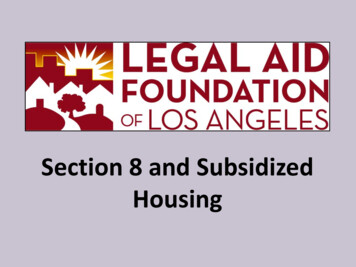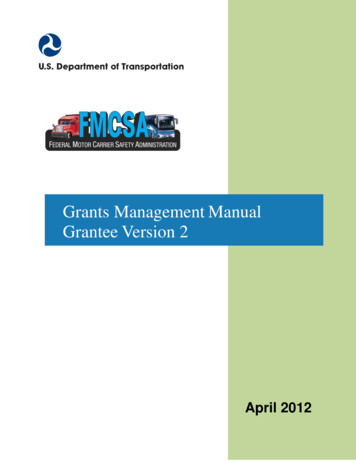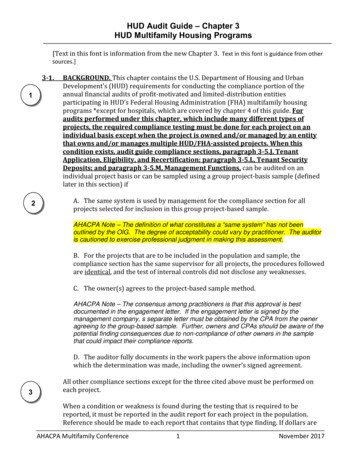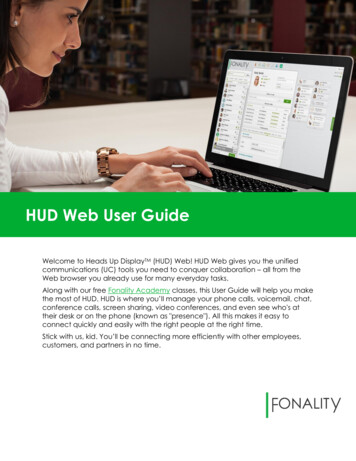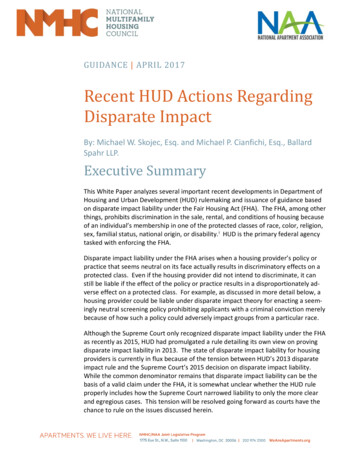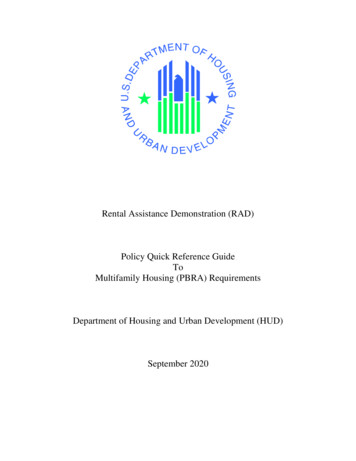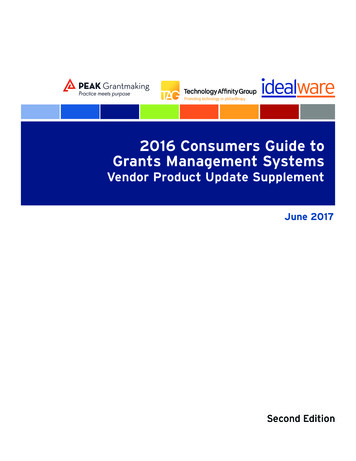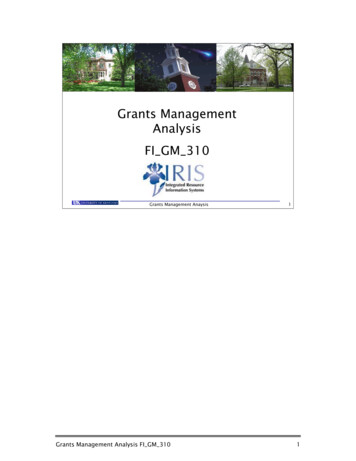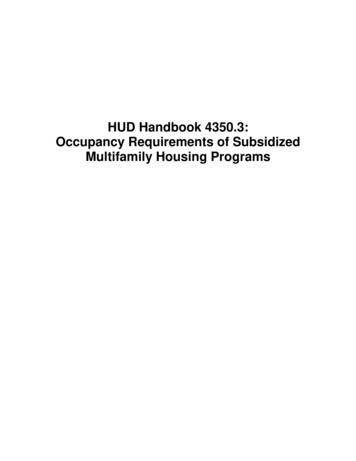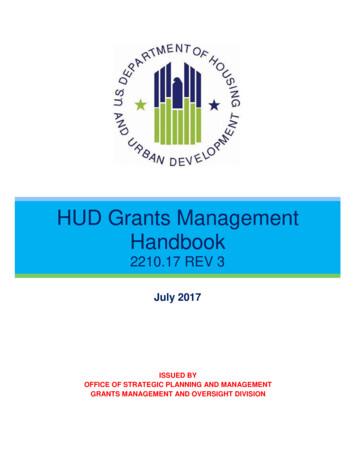
Transcription
HUD Grants ManagementHandbook2210.17 REV 3July 2017ISSUED BYOFFICE OF STRATEGIC PLANNING AND MANAGEMENTGRANTS MANAGEMENT AND OVERSIGHT DIVISION
HUD GRANTS MANAGEMENT HANDBOOK 2210.17 REV 3HUD Grants Management HandbookJuly 2017Table of ContentsCHAPTER I: GENERAL INFORMATION . 31- 1PURPOSE. 41–2ENTERPRISE RISK MANAGEMENT (ERM) . 51–3APPLICABILITY . 51-4FEDERAL FINANCIAL ASSISTANCE . 61–5GRANTS MANAGEMENT ROLES AND RESPONSIBILITIES . 91-6DEFINITIONS . 131-7GOVERNMENT-WIDE AND HUD REQUIREMENTS FOR GRANTSMANAGEMENT . 13CHAPTER II: PRE-AWARD . 192–1PROGRAM PURPOSE AND INSTRUMENT SELECTION . 202-2PAPERWORK REDUCTION ACT AND CATALOG OF FEDERAL DOMESTICASSISTANCE . . 212–3ANNUAL MILESTONE PLAN. 222–4NOTICES OF FUNDING OPPORTUNITIES . 242–5NOFA AND NOTICE REQUIREMENTS. 292 -6NOFA CLEARANCE. 352–7APPLICATION RECEIPT AND REVIEW PROCEDURES FOR COMPETITIVEAWARDS . 392–8APPLICATION MERIT REVIEW . 402–9RENEWALS . 452 – 10 UNSOLICITED PROPOSALS . 472 – 11 RESEARCH INVOLVING HUMAN SUBJECTS . 472 – 12 PRE-AWARD RISK ASSESSMENTS (2 CFR 200.205) . 482 - 13 FUNDS COMMITMENT. 512 – 14 AWARD NOTIFICATION REQUIREMENTS . 522 – 15 PROGRAM OFFICE RESPONSIBILITIES AFTER AWARDANNOUNCEMENT . 53CHAPTER III: AWARD . 553–13–23–3ISSUING AN AWARD . 56INDIRECT COSTS (2 CFR 200.414) . 57INFORMATION CONTAINED IN A FEDERAL AWARD (2 CFR 200.210) . 58Page 1
HUD GRANTS MANAGEMENT HANDBOOK 2210.17 REV 33–4AWARD TRANSMISSION . 62CHAPTER IV: POST-AWARD. 634–14–24–34–44–5MONITORING (2 CFR 200, SUBPART D) . 64POST-AWARD REPORTING . 68RECORDS RETENTION. 70CLOSING A GRANT AWARD . 72AUDITS AND REVIEWS (2 CFR PART 200, SUBPART F) . 74APPENDIX A: DEFINITIONS . 77APPENDIX B: ABBREVIATIONS. 84APPENDIX C. GRANTS REQUIREMENTS BY GRANT CATEGORY . 86Page 2
HUD GRANTS MANAGEMENT HANDBOOK 2210.17 REV 3CHAPTER I: GENERAL INFORMATIONPage 3
HUD GRANTS MANAGEMENT HANDBOOK 2210.17 REV 31- 1PURPOSEThe Grants Management Handbook (Handbook) implements requirements for the U.S.Department of Housing and Urban Development’s (HUD’s) administration of grants andcooperative agreements. This handbook gives HUD Program and Administrative Offices auniform set of requirements staff must follow to fully implement OMB directives, federalstatutes, and regulations throughout the grant life cycle. This Handbook revises HUD GrantsHandbook 2210.17 REV 2 (January 23, 1992) and replaces it.Since 1992, numerous processes and procedures addressing advances in technology and thegrowing role of electronic government have been developed. The Department has worked tostreamline and simplify the application submission and reporting requirements for grants.Several significant pieces of legislation affecting the federal grants landscape have passed andtheir implementation is underway. They include: Federal Financial Assistance Management Improvement Act of 1999 (Public Law(P.L.) 106-107); Federal Funding Accountability and Transparency Act of 2006 (FFATA); Digital Accountability and Transparency Act of 2014 (DATA Act); Grants Oversight and New Efficiency Act of 2016 (GONE Act); 2 CFR part 200 – Uniform Administrative Requirements for Federal Grants, CostPrinciples, and Audit Requirements for Federal Awards issued by the Office ofManagement and Budget (OMB); and Circular No. A-123, Management’s Responsibility for Enterprise RiskManagement and Internal Control (issued by OMB in July 2016).The processes and procedures in this Handbook cover the functions associated with themanagement and stewardship of federal financial assistance by HUD staff. There are severalgrants management systems and processes used by HUD Program Offices. The Handbook onlyaddresses Department-level grants management and does not specify the use of any specificgrants management information system(s). If an enterprise-level grants management solution orsystem is implemented by the Department, this Handbook will be updated to reflect that change.The Office of Strategic Planning and Management (OSPM), Grants Management and OversightDivision (GMO) will provide updated information and procedures to Program Offices.The Handbook’s Pre-Award, Award, and Post-Award chapters reflect the steps in the grantsmanagement life cycle including: Receiving Congressional appropriations; Preparing a Notice of Funding Availability (NOFA) for publication on Grants.govor a Federal Register Notice (FRN) for renewals on HUD’s website and/or theHUD Exchange; Conducting a merit review or other comparative evaluation of applicationsubmissions for adherence to program rules and requirements; Preparing award documents, notifying Congress of applicants selected to receivethe awards and announcing funding approvals;Page 4
HUD GRANTS MANAGEMENT HANDBOOK 2210.17 REV 31 – 2 Issuing award documents to recipients with the terms and conditions of award;establishing payment accounts; and obligating funds; Monitoring program compliance and results; and Closing the award and recapturing unexpended funds.ENTERPRISE RISK MANAGEMENT (ERM)In response to new requirements in Circular A-123, HUD now requires the integratedmanagement of risk at strategic, program, and operational levels. This requirement includescreating a holistic view of risks for HUD and incorporating internal controls as a subset ofEnterprise Risk Management (ERM). Internal controls are tools to help manage risk and performmissions and operations. The Chief Risk Officer (CRO) and Risk Management Programdevelops the strategy for HUD to meet the new requirements and further operationalizesustainable risk management processes across HUD. The CRO and Risk Management Programwill assist HUD Program Offices to meet the OMB requirements by providing the tools,templates and methodologies to alignrisk management to the strategicobjectives of the organization.The Risk Management Program ispartnering with GMO to develop anenterprise view of risks around grantsat HUD. The processes and proceduresin this Handbook will evolve over timeas the ERM processes of thedepartment mature. For grantsmanagement, the ERM program willwork with stakeholders to furtherembed risk management into the dailybusiness of HUD operations. Workwill focus on helping Program OfficesF IGURE 1- ERM L IFECYCLEidentify, manage, and mitigate risks while integrating riskmitigation efforts across the department’s grants programs. ERM is an ongoing and continuouseffort which will be further developed and periodically reassessed with the input of the grantsstakeholder community.1 – 3APPLICABILITYThe Handbook establishes requirements for HUD Program Offices. It does not establishrequirements for recipients. It applies to Program Offices administering federal financialassistance programs. It will be updated as necessary to reflect changes in Departmentregulations or government-wide policy. For the Handbook, the term, “recipient” means a nonfederal entity as defined in 2 CFR 200.69. This includes a state, local government, Indian tribe,Page 5
HUD GRANTS MANAGEMENT HANDBOOK 2210.17 REV 3institution of higher education, or nonprofit organization administering the Federal award.“Recipient” also includes a for-profit organization, as permitted by 2 CFR 200.101(c).The Handbook: Reflects requirements in the Code of Federal Regulations (CFR), including HUD’sregulations at 24 CFR part 5, OMB’s regulations at 2 CFR part 200 (made applicableto recipients by 24 CFR 84.1 and 85.1 and the program regulations) and HUD’sOffice of the Chief Financial Officer’s Administrative Control of Funds: Policies andProcedures Handbook 1830.2 REV 6 (Funds Control Handbook); Cancels former versions of the HUD Grants Handbook; May not be cited in awards or publicly available documents, including NOFAs as it isan internal management document; and Promotes consistent grants management practices across HUD.2 CFR part 200 applies to federal awards made on or after December 26, 2014, and to awardswith terms stating the award will be subject to regulations as may be amended. 2 CFR part 84and/or 2 CFR part 85 (2013 edition) may continue to apply to older grants and cooperativeagreements. HUD Program Offices may elect to apply the requirements under 2 CFR part 200 toolder awards if they receive additional funding and new terms and conditions are issued. Theterms and conditions of some awards issued before December 26, 2014, provide that the awardsbecome subject to 2 CFR part 200 as of December 26, 2014. The audit requirements apply torecipients for the first full fiscal year on or after December 26, 2014. For prior fiscal years,OMB Circular A-133 must be used for audit requirements.Program Offices should note the requirements in this Handbook do not all flow from 2 CFR part200 and they may not all apply to every grant program. Appendix C outlines the specificprovisions applicable for both discretionary and mandatory grants. The list is not exhaustive.If the Handbook conflicts with requirements from a program statute or regulation issued by HUDor another federal agency, then those requirements will take precedence over the Handbook.Program Offices should notify GMO of any such conflicts.1 - 4 FEDERAL FINANCIAL ASSISTANCEThe Handbook covers procedures and processes governing all HUD financial assistanceprograms. (Please note HUD financial assistance programs may use different terminology, e.g.,Annual Contributions Contract and HOME Investment Partnership Agreement, but the awardinstrument for Federal financial assistance, is either a grant or cooperative agreement as requiredby the Federal Grant and Cooperative Agreement Act (31 U.S.C. 6301-08)).Page 6
HUD GRANTS MANAGEMENT HANDBOOK 2210.17 REV 3This includes related information in Section 2 -1, Program Purpose and Instrument Selection.The funding instrument used and the eligibility of recipients of grants, and cooperativeagreements must be consistent with the authorizing statute, program regulations and thisHandbook. The type of instrument must be specified in the funds control matrix for eachprogram. HUD staff are urged to consult with their program counsel when determining thefunding instrument to be used.A. TYPES OF AWARD INSTRUMENTS (2 CFR 200.201)1. Grant Agreements are used when the principal purpose of the relationship between HUDand the recipient is the transfer of money, property, services or anything of value toaccomplish a public purpose authorized by Congress and substantial federalinvolvement is not expected. Substantial federal involvement is not anticipated whenthe recipient is expected to operate the program without agency collaboration,participation or intervention.2. Cooperative Agreements are used when the principal purpose of the relationship betweenHUD and the recipient is the transfer of money, property, services or anything of value torecipients to accomplish a public purpose authorized by Congress, and substantialfederal involvement is expected. Substantial federal involvement occurs when HUDanticipates agency collaboration, participation or close agency oversight and controlduring the period of performance. Examples of substantial federal involvement include:a. Federal authority to halt activity if specifications or work statements are notmet;b. Review and approval of work elements must be obtained from HUD prior tocommencement of work;c. Review and prior approval of substantive provisions of proposed sub-grants orcontracts must be obtained beyond what is required by existing statutes orregulations;d. Highly prescriptive HUD requirements limiting recipient discretion;e. Review and approval of key personnel by the Program Office; andf. Substantial and direct HUD operational involvement or participation duringthe assistance activity.3. Fixed Amount Awards are a new type of grant agreement permitted by 2 CFR200.201(b). For a fixed amount award, HUD provides a specific level of funding withoutregard to actual costs incurred under the Federal award. HUD may use fixed amountawards if the project scope is specific and if adequate cost, historical, or unit pricing datais available to establish a fixed amount award based on a reasonable estimate of actualcost.B. CATEGORIES OF FUNDINGThere are two major categories of funding for HUD financial assistance: (1) discretionaryfunding and (2) mandatory funding.Page 7
HUD GRANTS MANAGEMENT HANDBOOK 2210.17 REV 31. Discretionary funding is a grant (or cooperative agreement) that allows HUD toexercise judgement in selecting recipients and determining award amounts through acompetitive, renewal, or unsolicited proposal process.2. Mandatory funding is a grant (or cooperative agreement) awarded under a programwhere the authorizing statute requires HUD to make an award to each eligiblerecipient under the conditions and in the amount specified in the statute. Awardamounts are usually determined by formula allocation. Block grants are the mostcommon types of mandatory funding.C. GRANT LIFE CYCLES: DISCRETIONARY AND MANDATORY FUNDINGThe grant process follows a life cycle that typically includes creating the funding opportunityor Notice, processing applications, making award decisions, administering the awards, andclosing out the awards. The specific actions in the life cycle are grouped in three mainphases: Pre-Award, Award, and Post-Award.Pre-AwardAwardPost-Award Establish Program Establish Program Funding Establish Program Forecast** Develop Funding Opportunity** Publish Funding Opportunity** Intake Application Finalize Award Selection** Commit Funds Complete Congressional Notification Assign Funds to Field Offices (if applicable) Issue Award Announcement & Notification Negotiate Award Agreement Obligate Funds Collect Financial and Program Information Issue Payments Conduct Monitoring Risk Analysis Conduct Monitoring Review Review Audit Require Corrective Conduct Eligibility Review** Evaluate Application** Conduct Risk Assessment** EstablishTerms and Conditions Finalize & Execute Agreement Establish UserAccess for GrantSystems Payment System Setup Process AmendmentsActions (ifapplicable) Resolve and Close Findings Award CloseoutThe life cycles for discretionary and mandatory funding are nearly identical, except in thePre-Award phase, as depicted above. Processes marked with a double asterisk do not applyto mandatory programs.The Pre-Award phase begins the grant life cycle, including announcing fundingopportunities and reviewing applications. For discretionary grant awards, it also includesconducting a pre-award risk assessment.Page 8
HUD GRANTS MANAGEMENT HANDBOOK 2210.17 REV 3The Award phase begins once HUD completes the application review process. ProgramOffices finalize awards and then notify Congress. The Award phase includes developing,finalizing and executing grant agreements or cooperative agreements. Grant amendmentsalso happen during this phase.The Post-Award phase includes monitoring, reporting progress, and completing closeoutrequirements for the award.1 – 5GRANTS MANAGEMENT ROLES AND RESPONSIBILITIESThis Section summarizes the federal agencies and HUD offices affecting the management ofHUD grant awards. It also explains the HUD grants workforce and the responsibilitiesinvolved in the administration of HUD awards.In this Handbook, the term “HUD Program Offices” or “Program Offices” refers to thesemajor organizational units within HUD awarding and managing federal financial assistanceand their sub-offices (i.e., Special Needs Assistance Programs; Office of AffordableHousing Programs; Economic Opportunity DivisionCommunityPlanning andDevelopmentFair Housingand EqualOpportunityHousingLead HazardControl andHealthy HomesPolicyDevelopment andResearchPublic and IndianHousingHUD Program Offices and their sub-offices use different approaches to grants managementand are organized differently. For example, some Program Offices have sub-officescontaining large organizational units, such as Offices, and Divisions with Branches. Forothers, the sub-offices are Divisions. Some Program Offices have centralized some of thegrants management functions. For example, the Grants Management Center (GMC) inPublic and Indian Housing (PIH) evaluates many grant applications and makes fundingrecommendations while CPD’s Office of Policy Development and Coordination handlesgrant closeout oversight.While Program Offices have flexibility in the assignment of grants managementresponsibilities to staff, work assignments should be made in alignment with federal grantsmanagement competency standards, grants management experience, Department standardsPage 9
HUD GRANTS MANAGEMENT HANDBOOK 2210.17 REV 3and/or a Program Office’s Standard Operating Procedures (SOP). Program Offices shouldalso consult with program counsel concerning developing grants management directives andnotices.A. KEY GRANTS MANAGEMENT ROLES1. Authorizing Officiala. The Authorizing Official (AO) in a Program Office oversees theimplementation of and adherence to HUD grants management requirements.The Authorizing Official must be appointed by the Secretary or his/herdesignee.b. The Authorizing Official has the authority to sign and approve Notices ofFunding Availability (NOFAs) or publication of notices and may delegate theauthority to sign NOFAs or notices. Current delegations of authority may befound here.2. Allotment Holdera. The Allotment Holder is the Assistant Secretary or equivalent, who submitsapportionment requests to the OCFO as needed to carry out responsibilities.He or she bears overall responsibility for the funds allotted to them. Often,the Authorizing Official and the Allotment Holder are the same person.b. Allotment Holders develop, submit, implement and enforce adequate fundscontrols and procedures. They also certify that the funds control matricesaccurately reflect practices within the Program Office and assign the role ofcommitting or obligating funds to Field Offices, where applicable. Foradditional information, see Chapter 1-6.2 of the Funds Control Handbook.3. Grants Manager (also may be Grants Officer, Grants Specialist, ProgramAnalyst, Program Official and/or Senior Program Staff member)a. Authorizing Officials may assign staff to manage pre-award, award, and postaward activities and maximize the integrity of grant programs from aprogrammatic, financial management, and administrative perspective.b. Grants managers ensure the assigned grant activities conform to HUD grantspolicy and regulatory requirements. These grant life cycle activities mayinclude:i.Setting program goals and objectives;ii.Drafting program regulations and NOFAs;iii.Managing grant competitions;iv.Advising on the scientific, technical and programmaticsuitability of applications for funding; andPage 10
HUD GRANTS MANAGEMENT HANDBOOK 2210.17 REV 3v.Administering the post-award activities of a program, whichmay include preparing, executing, and negotiating awards andterms and conditions.4. The Program Office may assign additional responsibilities to staff membersincluding those related to collaboration with program officials and others indevelopment, implementation, and evaluation of program plans, strategies,regulations, announcements, guidelines, and procedures.B. FEDERAL AGENCIESThe following is general information about the external organizations affecting theadministration of HUD grants.1. Office of Management and Budget (OMB) – Executive Office of thePresidentDevelops government-wide policy and issues guidance to federal agencies toassure grants are managed properly and federal dollars are spent under applicablelaws and regulations. OMB works cooperatively with the grant-making agenciesand the recipient community to create and maintain regulations and guidance.OMB also apportions appropriations to federal agencies; reviews and approvesregulations, NOFAs, and information collection requests.2. Department of the Treasury (Treasury)Establishes government-wide cash management policies, operating the system forprocessing of electronic payments, check payments, and certain transactions withstates. Treasury also manages the USAspending.gov website and the Do Not Pay(DNP) Business Center to support federal agencies. Treasury and OMB also leadthe government-wide implementation of the DATA Act.3. Government Accountability Office (GAO)Under various statutory authorities, GAO examines the use of federal funds;evaluates federal programs and activities; provides information, analyses, options,recommendations, and other assistance to help Congress make effective policy,funding, and oversight decisions.4. General Services Administration (GSA)Maintains government-wide databases for identifying and tracking awards,including the Catalog of Federal Domestic Assistance (CFDA) and System forAward Management (SAM).C. HUD OFFICESBesides the Program Offices shown above, other HUD offices impact theadministration of HUD grants, including:1. Office of the Secretary/Deputy Secretary - Provide Departmental leadershipthrough the management of HUD’s programs and activities.Page 11
HUD GRANTS MANAGEMENT HANDBOOK 2210.17 REV 32. Office of Strategic Planning and Management (OSPM) – Manages HUD’sstrategic planning and performance management by working with the Secretary,the senior leadership team, and external stakeholders. OSPM houses theDepartment’s Chief Risk Officer and Enterprise Risk Management efforts whichfacilitate the identification, tracking, reporting, and monitoring of risks across theenterprise; the Performance Division which helps develop, analyze, and report onkey agency performance indicators through the Annual Performance Plan; theTransformation Division which support’s HUD’s priority projects and agencywide strategic goals; and the Grants Management and Oversight Division.3. Grants Management and Oversight (GMO) Division - GMO, as part of OSPM,provides oversight and policy responsibility for HUD’s grant programs. TheDivision:a. Communicates federal statutes, regulations (including 2 CFR part 200)and Executive Orders governing the management of grant programs toProgram Offices;b. Advises Program Offices on grants management issues;c. Establishes processes to report on the timely obligation of funds andresults achieved;d. Promotes an enterprise-level view on grants management;e. Enhances management integrity by separating the duties andresponsibility of those establishing overall policy from those selectingrecipients for funding;f. Improves management efficiencies by streamlining and simplifyingprocesses associated with grants management consistent with theFederal Financial Assistance Management Improvement Act of 1999(P.L. 106-107) across HUD programs; andg. Facilitates the implementation of best practices from other agencies.4. Office of the General Counsel (OGC) - Advises GMO and the Program Officeson grant-related matters such as the applicability of statutory requirements,including annual appropriations acts, and program/grant regulatory requirements.5. Office of Inspector General (OIG) - The OIG makes independent audits andinvestigations of HUD programs, operations, and its recipients; conducts nationalevaluations to prevent fraud, waste, or abuse while promoting economy,efficiency, and effectiveness of departmental programs; and reviews responses toaudit reports and reports significant disagreements to the audit follow-up official.6. Office of Congressional and Intergovernmental Relations (CIR) - CIRestablishes the requirements for Congressional notification of grant awards,including the timing, content of the required notification, the transmissionPage 12
HUD GRANTS MANAGEMENT HANDBOOK 2210.17 REV 3procedures, and the means of acknowledging receipt, and, authorizing anyexceptions to the waiting period.7. Office of the Chief Financial Officer (OCFO) - The OCFO establishes andmaintains records and accounts showing the status of allotments issued toprogram offices; establishes and maintains official commitment, obligation, andpayment records; processes approved payment requests in a timely manner forpayment through the HUD financial systems and other mechanisms for electronicpayments; and advises on matters regarding budget development and execution,appropriations act provisions, and appropriations law (as defined by Chapter 1 –6.7 of the Funds Control Handbook)1 - 6 DEFINITIONSDefinitions can be found in Appendix A in the Handbook. The appendix is notintended to be an all-inclusive listing, but provides a single reference source for manydefinitions and abbreviations applicable to grants management used throughout theHandbook, including hyperlinks. See HUD regulations in Code of Federal Regulations(CFR) Title 24 – Department of Housing and Urban Development, for additionaldefinitions.1 - 7 GOVERNMENT-WIDE and HUD REQUIREMENTS FOR GRANTSMANAGEMENTA. OVERVIEW1. There are national, government-wide, and program requirements governingthe award. HUD must manage and administer Federal awards in a manner toassure HUD funding is expended and programs are implemented in fullaccordance with applicable requirements.2. HUD Program Offices must communicate these requirements to the recipientand must incorporate the requirements either directly or by reference in thegrant agreement or cooperative agreement. (2 CFR 200.210 and 2 CFR200.300)B. NATIONAL PUBLIC POLICY REQUIREMENTS (2 CFR 200.300)1. Public (or national) policy requirements, including but not limited toprotecting socio-economic and environmental rights, apply both pre- and/orpost-award. The requirements are usually applied government-wide, but maybe HUD-specific, based on the activities or recipients. The requirements areset forth in HUD regulations. Examples are bulleted below. They include, butare not limited to:a. Protection of civil rights (e.g., non-discrimination based on race,color, national origin, religion, sex, familial status, age, ordisability) (24 CFR 5.105); Fair Housing Act Title VI of the Civil Rights Act of 1964Page 13
HUD GRANTS MANAGEMENT HANDBOOK 2210.17 REV 3 Section 504 of the Rehabilitation Act of 1973, asamended;The Americans with Disabilities Act of 1990, asamended (ADA); andSection 109 of Title I of the Housing and CommunityDevelopment Act of 1974b. Use of human subjects in research (24 CFR 60.101); Participation in HUD-Sponsored Program Evaluationsc. Safety and health rights; Drug-Free Workplace (2 CFR part 2429 and the DrugFree Workplace Act of 1998) Handling of Hazardous and Biological Materials(Occupational Safety and Health Act of 1970, asamended); Labor Standards for Construction and NonConstruction (e.g., Fair Labor Standards Act, 29 USC§207, as amended; Davis-Bacon Act)d. The public’s right to information; Federal Funding Accountability and Transparency Act of2006 (2 CFR 200.211) Acknowledgment of federal funding, publications andcopyrights (2 CFR 200.315)e. Preserving natural or other resources and avoiding adverseimpacts on the human environment; HUD rules and regulations governing the environmentalreview process (24 CFR Part 50 and 58 – NationalEnvironmental Policy Act (NEPA) Process) National Historic Preservation Act (24 50.4 and 58.5) S
The Grants Management Handbook (Handbook) implements requirements for the U.S. Department of Housing and Urban Development’s (HUD’s) administration of grants and cooperative agreements. This handbook gives HUD Program and Administrative Offices a uniform set of requirements sta

